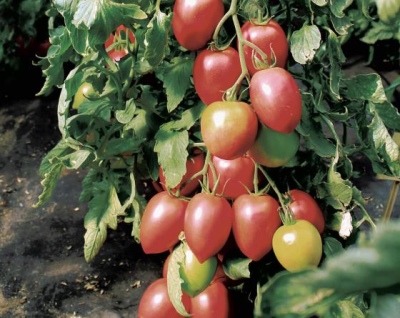
- Authors: Vilmorin S. A., France
- Year of approval: 2016
- Name synonyms: Bonaparte
- Category: hybrid
- Growth type: indeterminate
- Appointment: fresh consumption, for pickling and canning, for whole-fruit canning
- Ripening period: mid-season
- Ripening time, days: 50-55 days from planting seedlings in the ground
- Growing conditions: for open ground, for film greenhouses
- Transportability: good
If the personal plot is small, then it is recommended to grow hybrid varieties of tomatoes that are absolutely not inferior in yield and taste of fruits. One of the favorites among farmers and summer residents is the Bonaparte hybrid tomato.
Breeding history
An early ripe hybrid variety was bred by the breeders of the French company Vilmorin not so long ago - at the end of 2014, but despite this, it managed to win the attention of many farmers and gardeners in Russia. Included in the State Register and approved for use in 2016. Zoned into many regions (Central, Middle Volga, East Siberian, Northern).
Description of the variety
Tomato Bonaparte belongs to the class of plants with an indeterminate type of growth. The bushes are tall, reaching a height of 200 cm, characterized by a balanced trunk with short internodes and dark green foliage. A mid-season variety can be planted in open ground and in greenhouses, while they do not take up much space. The bushes are tall, so a garter is required.
The main qualities of the fruit
The Bonaparte tomato is egg-shaped and pink-red when fully ripe. Unripe tomato is light green in color. On average, the weight of one fruit is 180-220 grams, however, in some cases, when the ovaries are rationed, tomatoes grow to 400 g. Tomatoes have a perfectly smooth and dense skin, due to which they do not crack, do not lose their presentation during transportation and storage.
Taste characteristics
The taste of tomatoes is excellent. They are freshly sweet, fleshy, rather juicy. In addition, tomatoes have a pronounced aroma, which is why they are incredibly harmonious in summer salads. The Bonaparte variety is universal, so it is eaten fresh, canned whole, in the form of sauces, juices, and various dressings.
Ripening and fruiting
Since the variety is mid-season, it will take about two months for growth and ripening from the moment the seedlings are planted in the ground to tasting the first harvest.
Yield
The yield indicators for this species are excellent. With proper agricultural technology, up to 12-14 kg can be harvested from 1 m2. The yield of tomatoes grown in greenhouse conditions is slightly higher than that of those grown in the open field.
The timing of planting seedlings and planting in the ground
Sowing seeds for growing seedlings is carried out throughout March (depending on the climatic conditions of the region). To do this, prepare the soil and a room in which the temperature should be + 20 ... 23 degrees and good lighting for 14-16 hours a day. As soon as 4-6 leaves appear in the seedling bushes, you can make a pick. For 10-14 days, the seedlings must be hardened, and then planted in open ground.
As a rule, planting of seedlings in open ground occurs in mid-May. Wells with a depth of 6-7 cm are prepared in advance. During the growth and development of seedlings, do not forget about pinching and tying to supports, prepared in advance.

Growing tomato seedlings is an extremely important process, because it largely depends on whether the gardener can harvest at all. All aspects must be taken into account, from seedbed preparation to planting in the ground.
Landing scheme
When planting in a permanent place, you need to follow some rules - no more than 4 bushes are planted per 1 m2. The optimal planting pattern is 70x40 cm.

Growing and care
The selected area for planting seedlings is preliminarily fluffed to increase air permeability and cleared of weeds. The soil should be fertile, well lit by sunlight and protected from drafts and gusty winds. Crop care includes the following procedures - soil loosening, watering, feeding, garters.




A plant needs different micronutrients at each stage of growth. All fertilizers can be divided into two groups: mineral and organic. Folk remedies are often used: iodine, yeast, bird droppings, eggshells.
It is important to observe the rate and period of feeding. This also applies to folk remedies and organic fertilizers.
Disease and pest resistance
The variety is resistant to diseases, viruses and pests, so cladosporium, tobacco mosaic and fusarium wilting are not afraid of it. To prevent the development of various diseases, it is enough to carry out preventive spraying.


Resistant to adverse weather conditions
The vegetable culture is resistant to weather and temperature fluctuations, so this does not affect the quality of the crop. In the southern regions, it is optimal to plant tomatoes in open ground, and in areas with long and harsh winters - in greenhouses.
Growing regions
Tomatoes can grow in all regions of the country. The exceptions are zones with a very unstable and unfavorable climate.
Review overview
The French tomato Bonaparte is a frequent visitor to vegetable gardens and backyard plots, since it is absolutely unpretentious in care, has excellent taste, is protected from many diseases and viruses, and also quickly adapts to climate and soil. In addition, the compactness of the bushes, which are easily tied up, uniform ripening of tomatoes and sufficient keeping quality are noted.

























































































